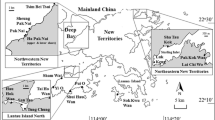Abstract
An updated survey, using both random transect and walk-through search methods, at 17 shores in Hong Kong in summer and winter showed that juvenile horseshoe crabs (Tachypleus tridentatus and Carcinoscorpius rotundicauda) were significantly reduced by over 90% in density since 2002. Of the shores where juveniles were found, the highest density of T. tridenatus was 0.31 and lowest 0.08 ind 100 m–2. Juvenile C. rotundicauda was only found using the walk-through search method, with the highest record of 1.17 and lowest 0.17 ind hr–1 person–1. The mean prosomal width of juvenile T. tridentatus obtained from the walk-through survey varied from 2.6 to 5.5 cm, which corresponded to an age of 4–8 years old. A larger size range for C. rotundicauda was, however, noted, from 2.5 to 9.0 cm.
The degree of human exploitation of adult horseshoe crabs (T. tridentatus) in Hong Kong was estimated through interviewing 34 seafood restaurants, 150 fish sellers and fish handlers, and fishermen in two local fish wholesale markets over a 13-month study period. A total of 1,023 horseshoe crabs were caught in 2004–2005, with 72% from mainland Chinese waters. Apart from releasing back to sea, an average sale of 17 horseshoe crabs per month was estimated. While the sale of horseshoe crabs was low by comparison with other marine species of economic importance, human exploitation still contributes a potential threat and puts further pressure on the mature population of horseshoe crabs in Hong Kong due to their long maturity period and declining densities of the juveniles.
Access this chapter
Tax calculation will be finalised at checkout
Purchases are for personal use only
Similar content being viewed by others
References
Chen CP, Yeh HY, Lin PF (2004) Conservation of the horseshoe crab at Kinmen, Taiwan: strategies and practices. Biodivers Conserv 13:1889–1904
Chiu HMC, Morton B (1999a) The biology, distribution and status of horseshoe crabs, Tachypleus tridentatus and Carcinoscorpius rotundicauda (Arthropoda: Chelicerata) in Hong Kong: Recommendations for conservation and management. Final Report. The Swire Institute of Marine Science, The University of Hong Kong
Chiu HMC, Morton B (1999b) The distribution of horseshoe crabs (Tachypleus tridentatus and Carcinoscorpius rotundicauda) in Hong Kong. Asian Mar Biol 16:185–196
Chiu HMC, Morton B (2003a) The status of horseshoe crabs in Hong Kong. In: Morton B (ed) Perspectives on Marine Environmental Change in Hong Kong and Southern China. Proceedings of the Hong Kong Workshops Reunion Conference on Perspectives on Marine environmental Change in Hong Kong and Southern China (1977–2001). Hong Kong University Press, Hong Kong, pp 743–758
Chiu HMC, Morton B (2003b) The morphological differentiation of two horseshoe crab species, Tachypleus tridentatus and Carcinoscorpius rotundicauda (**phosura), in Hong Kong with a regional Asian comparison. J Nat Hist 37:2369–2382
Chiu HMC, Morton B (2004) The behaviour of juvenile horseshoe crabs, Tachypleus tridentatus (**phosura), on a nursery beach at Shui Hau Wan, Hong Kong. Hydrobiologia 523: 29–35
Earle SA (1991) Sharks, squids, and horseshoe crabs – The significance of marine biodiversity. BioScience 41:506–509
Itow T (1998) The pollution of coastal waters and malformations of horseshoe crab embryos. Bull Fac Educ Shizuoka Univ Nat Sci 48:15–33
Mikkelsen T (1988) The Secret in the Blue Blood. Science Press, Bei**g
Morton B, Lee CNW (2003) The biology and ecology of juvenile horseshoe crabs along the northwestern coastline of the New Territories, Hong Kong: Prospects and recommendations for conservation. Final Report to China Light and Power Company Limited. The Swire Institute of Marine Science, The University of Hong Kong, Hong Kong, pp 91
Morton B, Williams GA, Lee SY (1996) The benthic marine ecology of Hong Kong: a dwindling heritage. In: Coastal Infrastructure Development in Hong Kong. A Review. Proceedings of the Symposium on Hydraulics of Hong Kong Waters, Civil Engineering Office, Civil Engineering Department, Hong Kong Government, pp 233–267
Sekiguchi K (1988) Biology of Horseshoe Crabs. Science House Co., Ltd., Tokyo
Acknowledgments
We would like to thank funding support from the Environment and Conservation Fund from the Hong Kong Special Administrative Region Government and Woo Wheelock Green Fund, Hong Kong. The presentation of this paper at the International Symposium on Science and Conservation of Horseshoe Crabs was supported by a travel grant from the Scientific Committee on Ocean Research, International Council of Science, USA.
Author information
Authors and Affiliations
Corresponding author
Editor information
Editors and Affiliations
Rights and permissions
Copyright information
© 2009 Springer Science+Business Media, LLC
About this chapter
Cite this chapter
Shin, P.K., Li, H., Cheung, S.G. (2009). Horseshoe Crabs in Hong Kong: Current Population Status and Human Exploitation. In: Tanacredi, J., Botton, M., Smith, D. (eds) Biology and Conservation of Horseshoe Crabs. Springer, Boston, MA. https://doi.org/10.1007/978-0-387-89959-6_22
Download citation
DOI: https://doi.org/10.1007/978-0-387-89959-6_22
Published:
Publisher Name: Springer, Boston, MA
Print ISBN: 978-0-387-89958-9
Online ISBN: 978-0-387-89959-6
eBook Packages: Biomedical and Life SciencesBiomedical and Life Sciences (R0)




